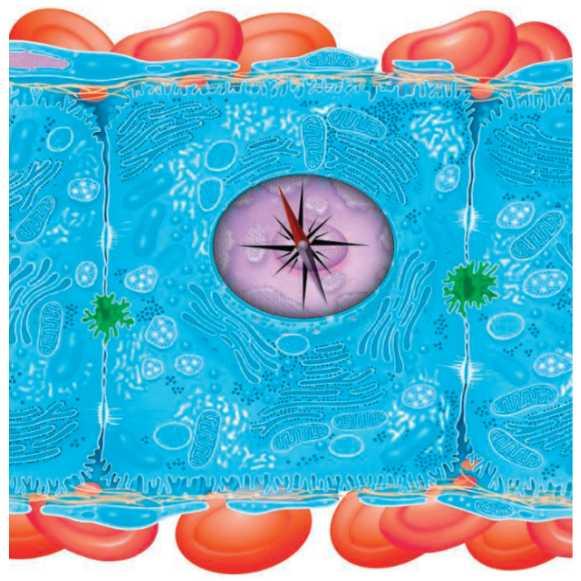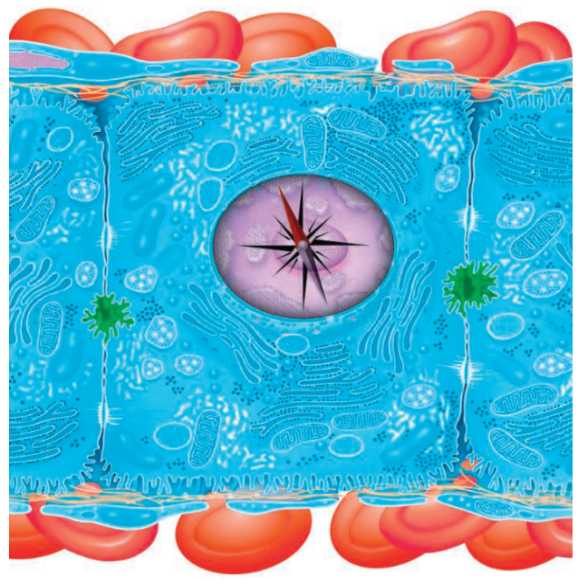Extracellular Matrix and Cardiovascular

Introduction of extracellular matrix
Extracellular matrix (ECM) is a kind of macromolecular substance synthesized and secreted by fibroblasts, mesenchymal cells and epithelial cells and the like. Extracellular matrix is mainly divided into four large categories: collagen, non-collagen glycoprotein, proteoglycan and elastin. They mainly distributed and aggregated on the cell surface and interstitial cells, often form a complex network structure, so called extracellular matrix. They are the external environment on which cells and tissues depend for survival, activity and regulation; on the one hand, they provide physical protection for cells and tissues, such as support, linkage, fixation, water retention, buffering, etc., on the other hand, they are intermediary for exchange, information transfer and collection between cells and the external environment. It can regulate various physiological functions such as cell growth, proliferation, migration, differentiation, adhesion, metabolism, damage repair, and tissue remodeling through various signal transmission systems. It is considered to be the main regulator of homeostasis in human cells and tissues.
The composition of the extracellular matrix is very complex. In addition to various types of collagen, there are more than ten categories, such as types of fibronectin, laminin, glycosaminoglycan, proteoglycan, elastin, vasopressin, thrombomodulin, integrin, vitronectin, connexin, cadherin, selectin, adhesin, and cell adhesion. There are several to dozens of subtypes in each category. The matrix components produced and secreted by the different cells are different; the composition and ratio of the extracellular matrix contained are different in the different tissue; even the same cell or tissue, under different physiological, pathological and reaction conditions, the extracellular matrix's composition, structure and configuration are also different; the different of structure and configuration will cause the different function of extracellular matrix; the same type of extracellular matrix can be decomposed into different degradation fragments and also have different physiological functions. With the advancement of genes and proteomics, new extracellular matrix molecules are still being born, and their functions and types have been gradually understood and expanded to form a very complex network family and system of extracellular matrix.

The function of extracellular matrix
Although the extracellular matrix has different origins, components, types and functions, but in structure and function, they are arranged in order, the density interaction, interconnected, and synergistically, various complex and relatively fixed forms and layered network structures are formed, forming a plurality of different functional structural regions in the intercellular substance, interstitial space and within the organ, such as in the blood vessel, can form adhesive protective layer, intima layer, basement membrane layer, internal elastic layer, external elastic layer, middle layer of blood vessel and connective tissue of outer layer mesangium in intimal surface. Each structural region has its complex composition, structure and respective functions, forming multiple channels, scaffolds, partitions or barriers to protect and regulate the complete function of the blood vessels. Extracellular matrices are derived from different cells within organs and tissues. Different cells produce and secrete different substrates. For example, in the heart, muscle cells can produce collagen IV, VI, laminin and proteoglycans; endothelial cells can produce collagen I, III, IV, LN and FN; Fibroblasts can produce collagens I, III, FN, Periostin and the like. Other cells in tissues and organs, such as inflammatory immune cells, can also produce and secrete a variety of extracellular matrices, cells and growth factors, as well as their associated proteases. However, in these cells, fibroblasts remain the most important source of extracellular matrix, especially in response to injury repair and tissue remodeling.
The extracellular matrix is relatively stable, and both soluble and insoluble macromolecular species have a relatively fixed distribution and presence under normal physiological conditions. However, its metabolism is very active. They are constantly being produced and degraded. Matrix metalloproteinases (MMPs) and metalloproteinase inhibitors (TIMPs) play an important role in these processes. More than 30 MMPs and more than 20 TIMPs have been discovered in vivo. MMPs can degrade a variety of collagen and extracellular matrix molecules; TIMPs can bind to various MMPs and inhibit the action of MMP to maintain the homeostasis of the extracellular matrix. This creates a complex, dynamic, and tunable synthetic and metabolic network of ECM-MMP and TIMP. The network centered on the extracellular matrix in the extracellular and interstitial space. This network system can also combine with a variety of cytokines, growth factors and cardiovascular active substances to aggregate and integrate a variety of cellular information transmission pathways, which can not only regulate the functional activities of cells and organs, but also regulate the production and secretion of various extracellular matrix, and regulating the expression and role of MMP and TIMP. Together, they form a complex ECM network regulation the microenvironment of system, cell, tissue and organ, and ensure the normal function of cells, tissues and organs. This is beneficial with the response to various physiological and pathological stimuli. They are managers of the environment in which cells and tissues live, and are also agents, bridges, and regulatory sites within and outside the cell environment.
The relationship between extracellular matrix and cardiovascular
As a regulator of cell and tissue homeostasis, the extracellular matrix not only participates in the formation, development, repair and regeneration of various tissues, embryos, organs, but also helps to complete the integration and transmission of information for multiple factors. Extracellular matrix play an important role in various functions of the cell. Therefore, the extracellular matrix is involved in the development and progression of various diseases. In the cardiovascular system, it is involved in cardiovascular development, angiogenesis, vascular remodeling, cell adhesion and thrombosis, subendothelial migration and proliferation of smooth muscle cells, contraction and relaxation of myocytes, hypoxia, inflammatory immunity. In addition, there is a close relationship between cardiovascular physiology and pathological processes such as plaque formation, vascular sclerosis and myocardial fibers. Thus it is of great significance in the pathogenesis of cardiovascular disease.
In the case of cardiovascular disease, the extracellular matrix will show a related change with the onset of cardiovascular disease: in the early stage of the disease, it is often manifested by abnormal regulation of ECM network, such as growth factor, active substance, MMP/TIMP expression change; exogenous matrix protein expression changes, synthesis and degradation balance is broke, ECM component ratio changes; and then the composition, configuration, conformation of ECM changes. These changes affect the support, barrier, information aggregation and transmission functions of ECM, which in turn cause changes in cell phenotype and tissue structure, and finally produce pathological and tissue damage, causing various serious cardiovascular diseases and their complications. Different cardiovascular diseases have different changes in extracellular matrix; even for the same cardiovascular disease, the changes in the extracellular matrix are different. However, these changes are important pathological basis for the occurrence and development of cardiovascular diseases, as well as important biomarkers and target molecules for the diagnosis and prevention of cardiovascular diseases.
References:
- Michel G, et al. The cell wall polysaccharide metabolism of the brown alga Ectocarpus siliculosus. Insights into the evolution of extracellular matrix polysaccharides in Eukaryotes. New Phytologist. 2010, 188 (1): 82–97.
- Abedin M, Nicole K, Diverse evolutionary paths to cell adhesion. Trends in Cell Biology. 2010, 20(12): 734–742.
- Brownlee, Colin. Role of the extracellular matrix in cell-cell signaling: paracrine paradigms. Current Opinion in Plant Biology. 2002, 5 (5): 396–401.
- Karsenty G, Park RW. Regulation of type I collagen genes expression. Int. Rev. Immunol. 1995,12 (2–4): 177–185.
- Hynes, R. O. The Extracellular Matrix: Not Just Pretty Fibrils. Science. 2009, 326(5957), 1216–1219.
- Art
- Causes
- Crafts
- Dance
- Drinks
- Film
- Fitness
- Food
- Jogos
- Gardening
- Health
- Início
- Literature
- Music
- Networking
- Outro
- Party
- Religion
- Shopping
- Sports
- Theater
- Wellness
- IT, Cloud, Software and Technology


